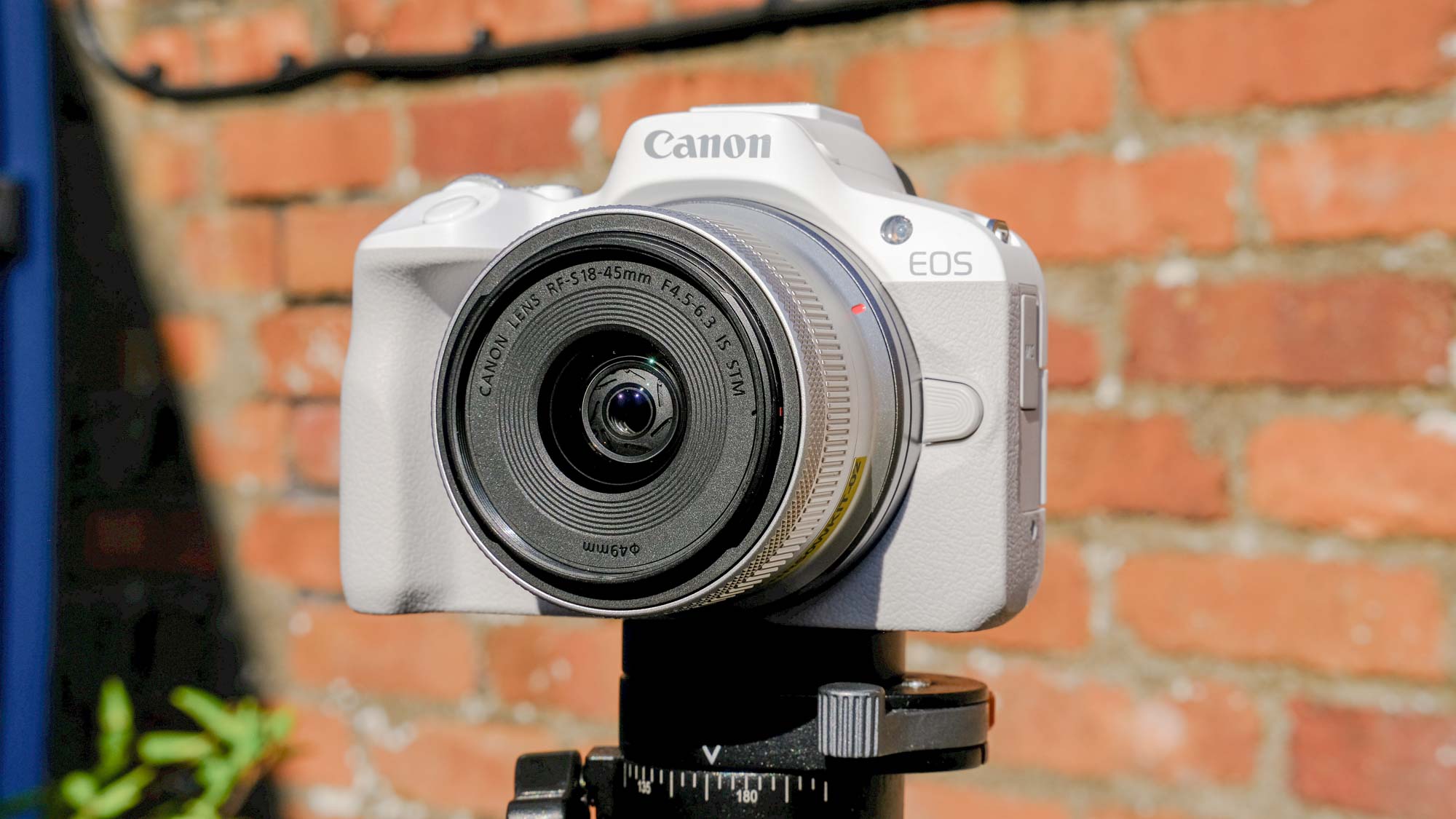
Sensor: 24.2MP APS-C
Processor: DIGIC X
Stabilisation: Optical and Electronic only (no IBIS)
AF system: Dual Pixel CMOS AF II, 651-Zone
Viewfinder: 0.39 inch OLED EVF, 2.36 million dots
Display: 3.0 inch Vari-Angle touch screen LCD, 1.62 million dots
ISO range: ISO 100 - 32000 (expandable to 51,200)
Max video resolution: 4K @ 30p
Ports: USB-C, Micro HDMI, 3.5mm external mic, 1x SD/SDHC/SDXC UHS-I
Wireless/bluetooth: Wi-Fi & Bluetooth
Max shooting speed: 12fps mechanical; 15fps electronic
Max shutter speed: 1/4000 mechanical; 1/8000 electronic
Battery life (CIPA): 440 shots
Size/weight: 4.57 x 3.36 x 2.70 inches; 13 ounces
The Canon EOS R50 is the camera Canon wants social media influencers to buy after realizing they need more than a smartphone. This mirrorless camera is targeted at people who want to focus on both photo and video, but don’t need something as beefy — or expensive — as the full-frame Canon EOS R8 and Canon EOS R6 Mark II.
It speaks to the effect that today’s video-centric landscape — particularly where social media is concerned — has had on the design of both consumer and professional cameras.
But it isn’t all show: Canon has kitted out the R50 with some decent video credentials, and true to its hybrid moniker, it comes with strong photo specs too. What’s more, we think that given the features on offer for the money, the R50 could be one of the best mirrorless cameras for beginners and those looking to make their first upgrade from a smartphone or a base level camera. Find out more in our Canon EOS R50 review.
Canon EOS R50 review: Price and availability
The Canon EOS R50 was released in February 2023, and costs $679 / £789, body only. Just like the EOS M50 Mark II, it’s available in both black and white colorways, and there are a number of kit options available. As with any RF-S mount camera, it’s disappointing that Canon have not yet released many native RF-S APS-C lenses, let alone any primes. But you can use full frame RF mount lenses, bearing in mind the 1.6x APS-C crop factor.
The most basic kit is the EOS R50 plus the RF-S 18-45mm F4.5-6.3 IS STM lens, which will set you back $799 / £900. Usually, I’d advise steering clear of kit lenses and focusing your resources on a fast prime lens. But the RF-S 18-45mm is actually a fantastic lens for vloggers. It’s sharp enough for nice-looking social media and YouTube content. It’s compact, yet features 4-stop optical stabilization to keep video steady and professional-looking when shooting handheld. It’s built well and its 18mm widest angle is equivalent to around 28mm in full frame terms — this is ideal for vlogging in small bedrooms or home offices and for fitting in your surroundings when shooting to camera outside. Better still, in our testing, the RF-S 18-45mm focused quickly, silently and without breathing — more boons for producing slick-looking video.
Its maximum aperture of f/4.5 isn’t great, but vloggers won’t want to go much wider than that anyway, as a very shallow depth of field can risk parts of your face being out of focus. And if you’re using one of the best ring lights, you’ll still be able to expose your image just fine.
You can also purchase a double-lens kit, also featuring the RF-S 55-210mm F5-7.1 zoom, for $1,029 / £1,099. This could be a good option for anyone also wanting a longer lens for wildlife photography or portraiture. However, if you don’t specifically need a telephoto zoom and will be focusing primarily on vlogging, we’d recommend sticking to the 18-45mm kit or going body-only with a fast, wide-angle prime like the tiny Canon RF 16mm F2.8 STM ($299 / £299).
Canon also offers vlogging bundles. The contents differ between the U.S. and U.K., the latter offering better value. Canon U.K. offers a bundle with the 18-45mm lens, a 3-in-1 tripod/grip/wireless remote, a shotgun mic and an SD card for just £50 more than the lens kit alone, which is highly competitive. In the U.S. you’re looking at an extra $100 for the same package but without an SD card.
In any kit, the R50 is pricier than the EOS M50 Mark II ($699 / £719). It’s also around $200 pricier than Canon’s current entry-level camera, the Canon EOS R100 ($599 / £669), but we feel the R100 offers comparatively little, even given the price delta between the two, justifying the extra spend.
Canon EOS R50 review: Design
The Canon EOS R50 is a compact little thing, weighing in at around 13 ounces and measuring only 4.5 inches at its maximum. Unless you’re wearing cargo pants, it isn’t pocket-sized, but it won’t cause any trouble when packing into a bag or carrying around your neck. Its low profile, ergo grip and articulating screen make it great for shooting at high, low or odd angles. The grip should make chunky lenses easier to handle too.
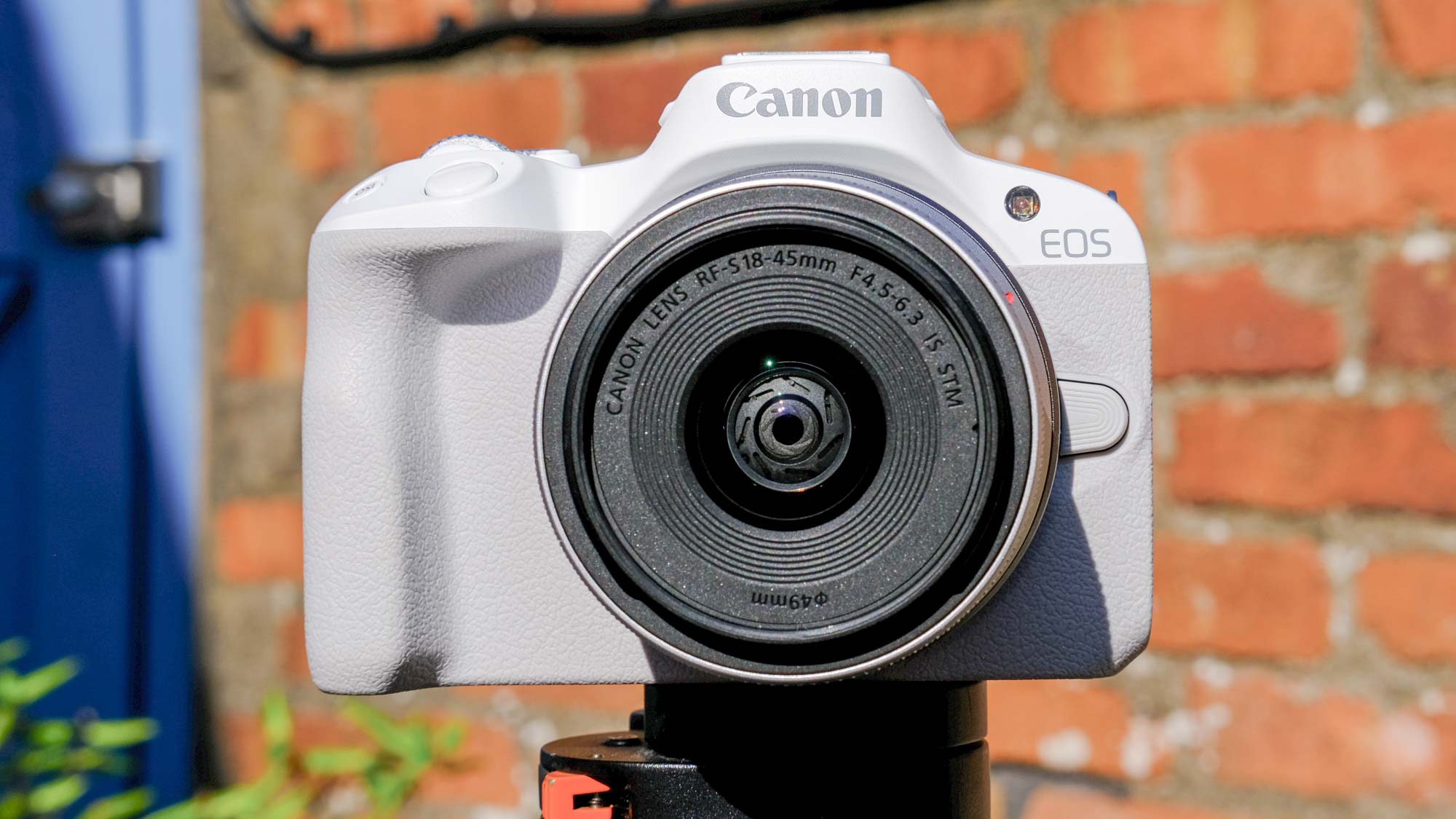
I tested the camera in white and gray case, with a silver lens. This won’t be to everyone’s taste — it’s about as subtle as a white Range Rover on chrome rims — but there’s a classic black colorway in case you don’t appreciate the look. The color grew on me: there’s an air of arctic fox about it, and I appreciate manufacturers providing choice, as it allows people to pick a camera they feel is an extension of them.
The EOS R50’s design is virtually the same as every other Canon EOS R-System camera. It’s a design ethos that’s just a streamlined version of Canon’s bulbous DSLR philosophy. They’re all relatively sleek and modern looking, especially when compared to an EOS DSLR, but Canon isn’t winning any awards for aesthetic bravery. Lurid white colorway aside, Canon’s current crop of mirrorless cameras say as much about your personality as wearing a plain white t-shirt. If you’d like something a little prettier, look at a Fujifilm X-E4 or Fujifilm X-T30 II.
Build and finish are impeccable. Buttons and dials are all either nicely damped or satisfyingly clicky, the only exception being the record button, which provides no haptic feedback whatsoever. This means you must look at the screen to confirm you’re recording.
The R50’s body is made of an aluminum alloy with high strength plastic, wrapped in grippy faux-leather: all feel sturdy. Oddly, despite being less expensive, the R50 feels higher quality than the Canon EOS R10, which I criticized for its hollow design that felt plasticky and cheap. This is down to the smaller grip of the R50, and the fact that Canon has had to pack everything into a tighter body, resulting in the camera feeling less hollow, and therefore more substantial.
The R50 has a 2.36M dot OLED electronic viewfinder (EVF), which packs enough resolution for detailed focus checking. It features a 120fps refresh rate, delivering smooth panning. The cheaper EOS R100 also features a 2.36M dot EVF, but is limited to only 60fps.
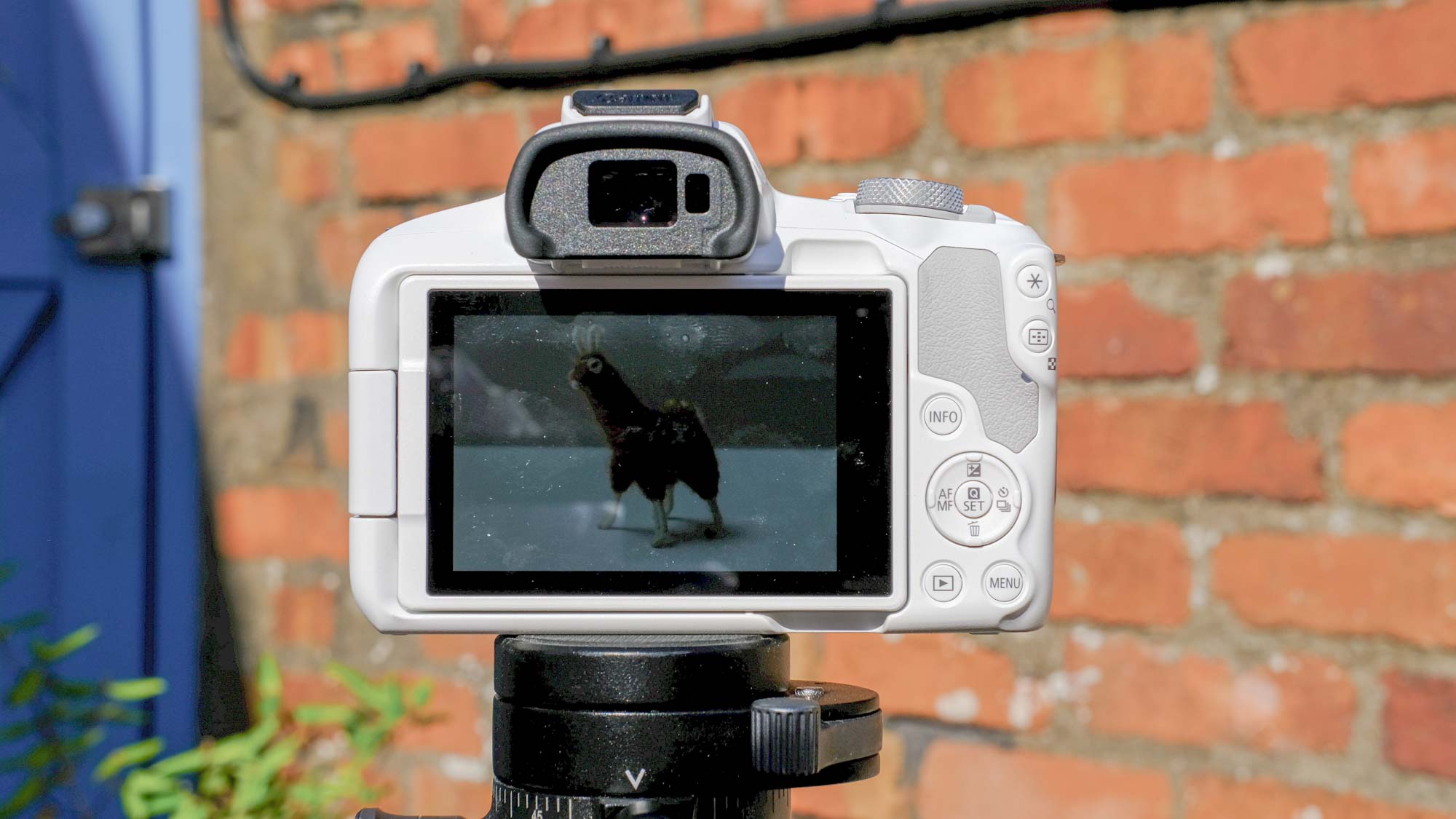
The EOS R50 also boasts a far superior rear display versus the R100. Firstly, its resolution is higher at 1.62M dots versus 1.04M dots, making it the better screen for viewing images and checking focus. Crucially, the EOS R50 has a fully articulating touch screen, whereas the R100’s display is completely fixed and non-touch — this is really quite abnormal in today’s camera market, and is a serious disadvantage for the cheaper R100. Screen articulation makes the R50 better for shooting at angles and better for vlogging, while a touch screen makes navigation easier.
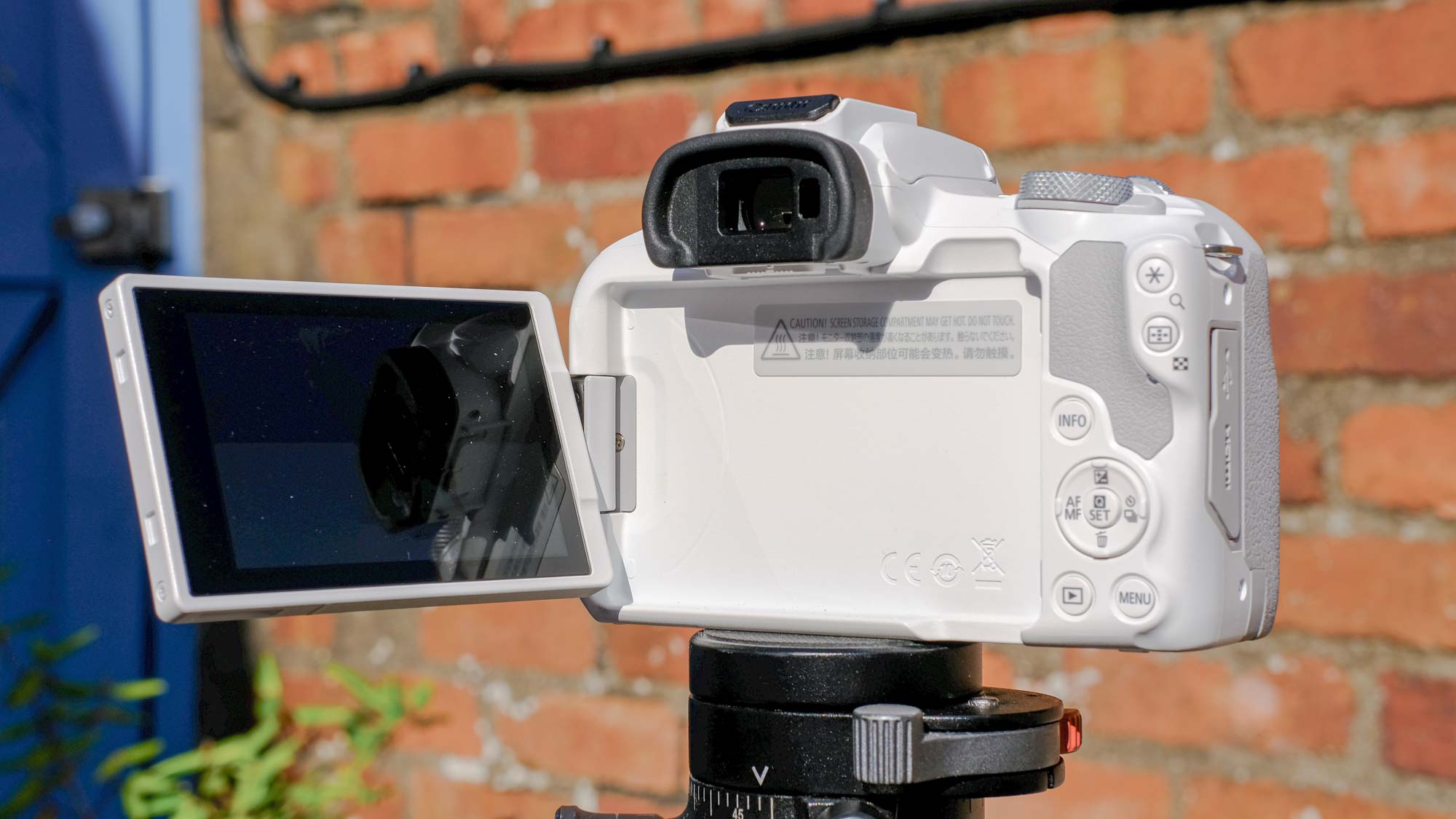
One feature I hated about the EOS R10 is the dioptric adjustment slider, sadly also present in the R50. I prefer a slider over a dial in theory, as it allows you to see and remember precisely where the adjustment needs to be set if switching to and from glasses. However, its placement under the EVF on both cameras renders it useless, as you can’t easily look through the EVF while adjusting it, which is the whole point.
The EOS R50 provides a decent number of connectivity options. Under the panels are USB-C, micro-USB and 3.5mm external microphone ports, allowing you to hook up a good number of accessories. There’s no headphone jack, though, meaning the EOS R50 isn’t equipped to monitor sound levels through headphones as you shoot — this would be something you may want if moving into higher quality video production long term.
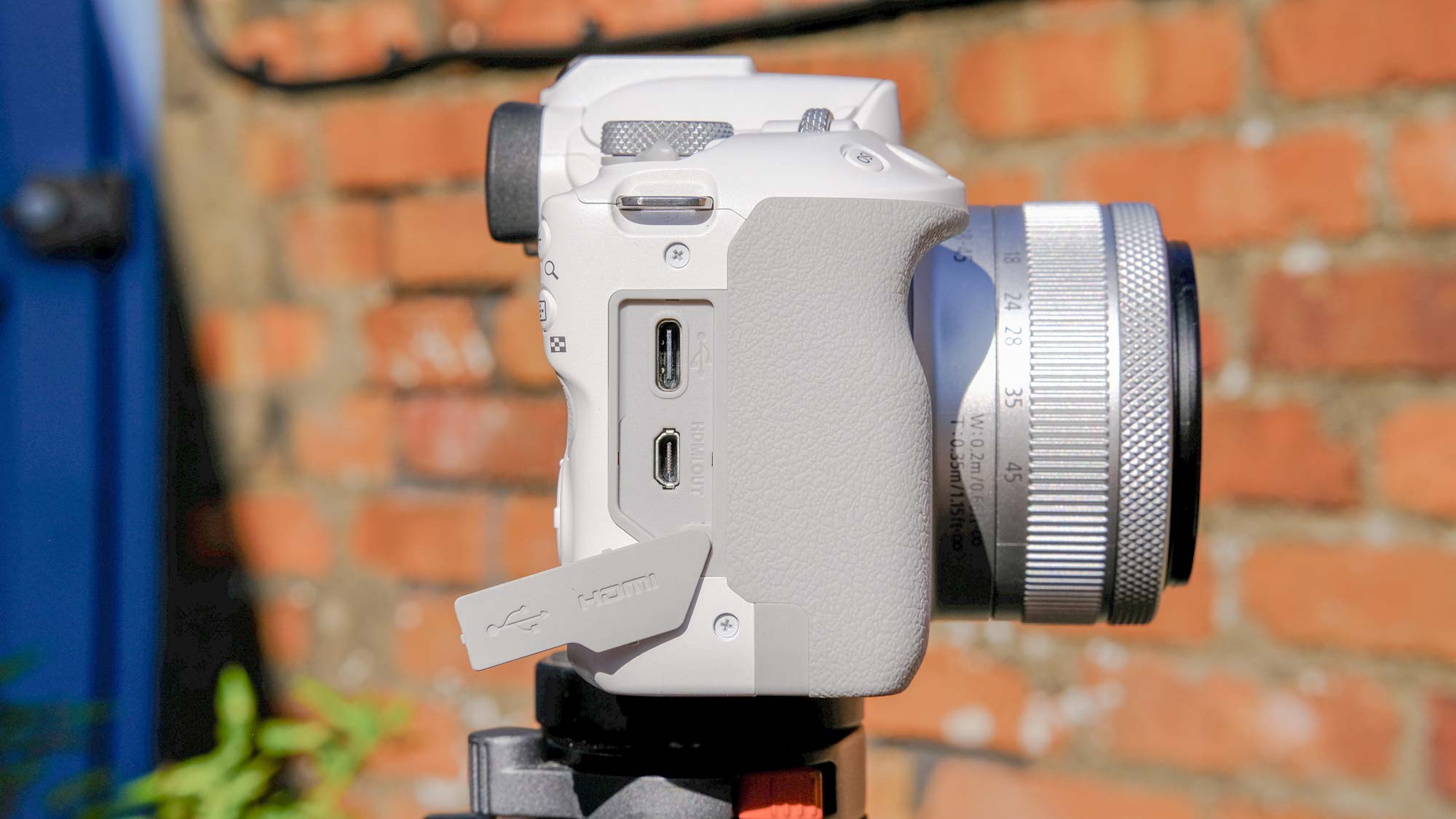
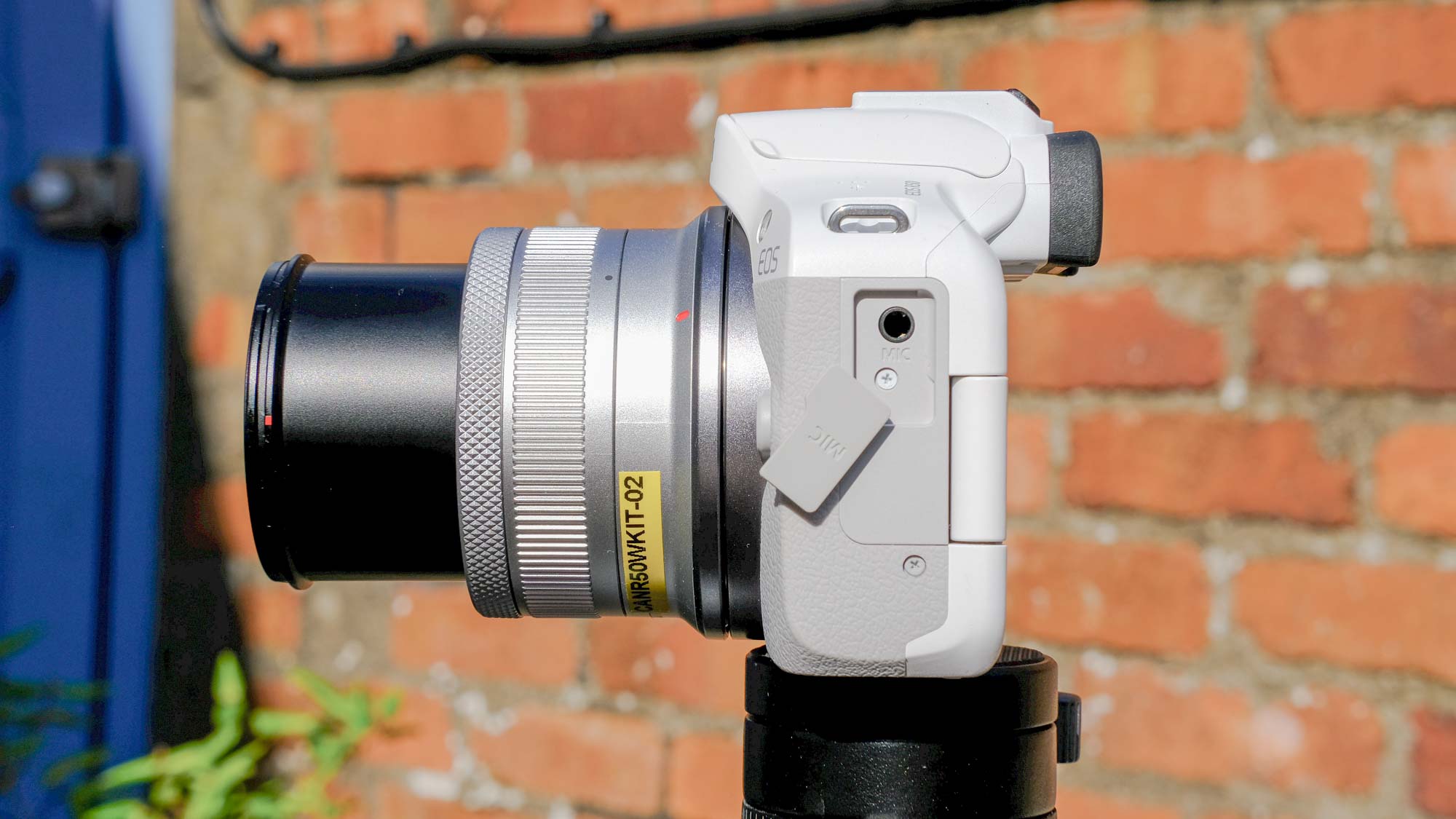
Similarly, there’s only a single SD slot, which supports UHS-I cards. While this means you won’t have access to the latest UHS-II SD cards, the EOS R50 can’t shoot the most demanding 4K/60p high bit-rate video to warrant a UHS-II card anyway. What may be an issue is that the single slot means you won’t have a backup of everything you shoot, which is a serious pain if the worst should happen and your card corrupts. At this price point, though, single-slot is the norm.
Canon EOS R50 review: Controls
The Canon EOS R50 is limited for serious photography by its controls, which is an issue we also had with the EOS R100. There are two controls for primary shooting parameters: an ISO button and a dial for either shutter speed or aperture. The problem is that three primary shooting parameters exist, meaning you have to choose either shutter or aperture to be controlled separately via the Q menu on screen. During fast-paced photography, you want all three at your fingers, and not to have to navigate a screen menu. This camera would really benefit from a second dial, and the lack of one is emblematic of it being geared towards auto shooters and vloggers.

Some full frame RF lenses feature an assignable control ring, which could be used for the third parameter (logically, aperture), but unfortunately this isn’t present on any of the native RF-S APS-C lenses, which is worth bearing in mind if considering this camera for photography long term.
The R50 also lacks a focus control joystick, which means you’ll have to tap the screen to choose focus points. For photography, this is a pain, as it makes changing focus points impossible to do when shooting through the EVF. The EOS R100 also lacks a joystick, as does the EOS R8 — very surprising, given the latter is an enthusiast-tier body.
Otherwise, controls are all laid out very sensibly. I had my reservations about the R50’s Magnify and AF Zone buttons at the top right of the rear, next to the raised rest — on the Fujifilm X-T30 II, I’m always knocking the Q-button, which is directly on the thumb rest — but I had no issues on the R50.
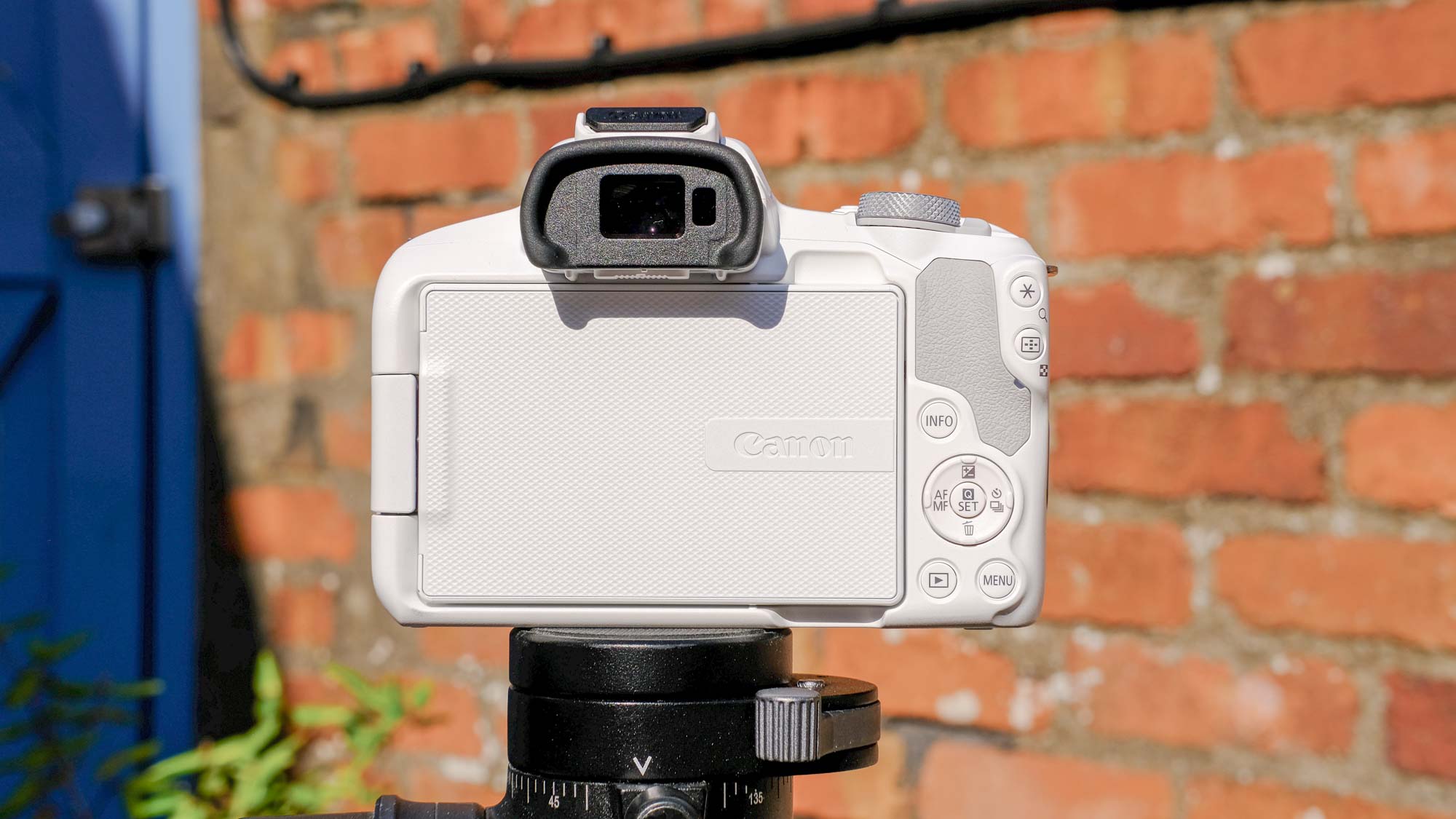
Top and rear controls are positioned within easy reach during both EVF and screen shooting — the d-pad, for example, lies right where you’d want it to be when moving your thumb down from the thumb rest. And for anything that isn’t on the camera’s body, there’s the all-encompassing customizable Q-menu to get you where you need. On top, there’s a large record button to commence video creation, which is easily nudgeable from the shutter button.
Canon EOS R50 review: Photo performance
The Canon EOS R50 shoots excellent quality stills, although this isn’t really a surprise. It’s difficult to find a bad sensor in modern interchangeable lens cameras (ILCs), and the 24.2MP sensor in the R50 has enough resolution to produce sharp, detailed images, even with the basic 18-45mm kit lens, even when cropped in. In this photo of a toy llama, you can see each wisp of the brown fibers.
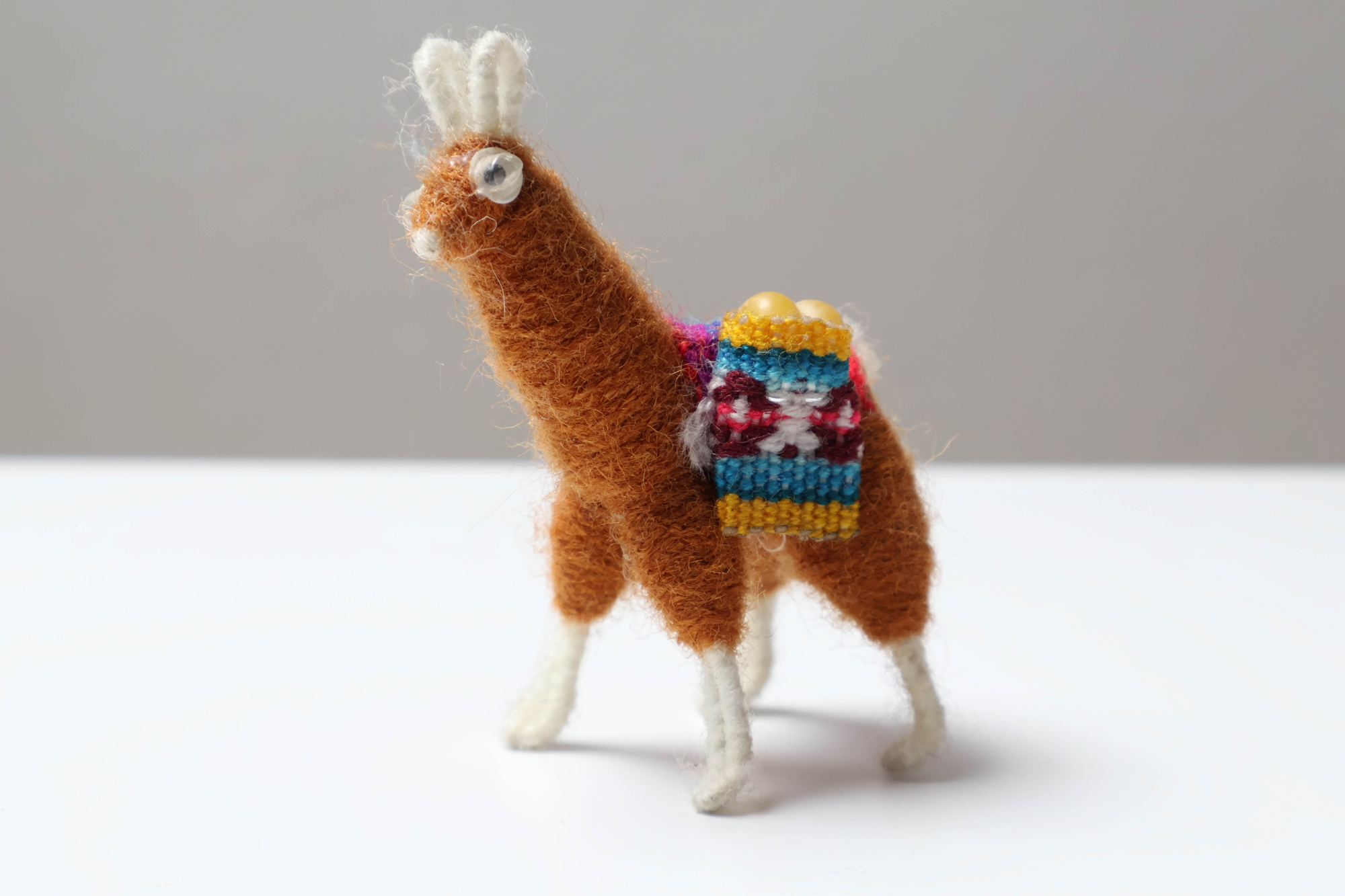
Canon cameras have a reputation for producing natural-feeling, pleasant colors, which the EOS R50 lives up to. Colors in Standard mode are true-to-life and only need a slight lift in post to pop. In the test shot of a Cardiff street, only minor changes were needed to make the blue sky and red awnings on the left look deep and vibrant, and to capture the warm sunlight falling on the stone buildings on the right-hand side. If you’d prefer though, there are numerous color profiles, such as landscape or portrait profiles, which will boost colors in various ways for great results straight out of camera. There’s also a Creative Assist mode, which is essentially an anti-jargon automatic mode. You choose what effect you want (i.e. out of focus background) and it sorts the settings for you — useful for beginners.
In automatic metering mode, the R50 did a fairly good job at capturing a wide dynamic range in the photo below. It kept the bright highlights of the white stadium towers in check, with detail still visible in the dark shadows of the alley, although it did blow out the brightest highlights in the clouds. Again, only slight tweaks were necessary to lift the colors of the image.

The EOS R50 comes with relatively impressive high speed shooting performance, managing 12fps using the mechanical shutter, 15fps using electronic. Here’s where you’ll start to notice the single, slow speed card, though. Shooting in RAW, the R50 is only capable of taking 7 images at high speed, so around half a second of shooting. This is not a camera built (or indeed priced) for high speed photography.
ISO performance is surprisingly good for a low-end APS-C camera, as demonstrated in the test images below. The first image is taken at ISO 100, and you can clearly see the texture and brush strokes of the gold metallic paint on the statue, the wisps of brown fabric strains on the toy llama, and the metallic shine of the brass greyhound. By ISO 6400, there’s a noticeable drop in detail with the statue and llama, while the brass has lost its shine, all thanks to the smoothing of noise suppression, but the image still looks decent.
By ISO 12,800 more detail has been lost thanks to smoothing and noise is now easily visible on the gray background, particularly around the brass greyhound model, but the image is still usable. By ISO 25,600, where I’d have expected the image to be destroyed by either noise, smoothing or both, it still looks OK. Again, smoothing and noise have continued to worsen and are both pretty heavy now, but I’ve seen a lot worse at that sensitivity.
Canon EOS R50 review: Video
The Canon EOS R50 shoots at 4K in 30p with no crop, which is what separates it from its elder siblings. The EOS R10, which costs around $200 more, offers 4K at 60p, with a crop, while the much more expensive EOS R7 offers 4K at 60p with no crop. The R100 shoots 4K at 25p, but as we’ve seen lacks a lot of features to make it a credible video tool, such as an articulating screen and intelligent AF. 4K 30p will be enough for many content creators wanting to produce higher quality video with more control than they could have using their smartphone. For this market, the difference between 30p and 60p may not be worth the extra money for the R10.
Where you’d definitely find the extra spend worthwhile for the EOS R10 is in regard to overheating. Canon claims the EOS R10 can record for up to an hour before overheating, and this proved accurate in our testing, as we didn’t see the overheating icon appear once while shooting test video. On the EOS R50, things are very different. Canon states that the maximum recording time for the R50 is 50 minutes at 4K. After shooting 4K video for around 15 minutes, the overheating icon appeared on the camera screen and kept creeping up even when I’d stopped shooting video and started playing back my footage. For a camera that’s aimed squarely at video creators, this is a bit of a disappointment, although if you’re shooting several-minute-long clips for socials or YouTube, it won’t be a huge problem in real terms.
For content creators, the main draw of the EOS R50 over similarly priced rivals is the autofocusing, which as we’ve already seen is excellent. However, it’s perhaps a bit too tenacious at times. This is a real nit-pick, as in general you want the camera to lock onto eyes in frame. However, I tested out some product demo scenarios in auto mode, bringing an action camera into frame to show it to the camera. If any of my face or eyes were in shot, the EOS R50 maintained its lock on those, so I had to try pretty hard to get it to refocus on the product. Luckily, the close-focusing RF-S kit lens allowed me to put the product near to the lens to obscure my face completely. With other lenses, though, especially those with longer minimum focusing distances, this could be an issue if product demonstrations are your thing. Certain rival vlogging cameras like the Sony ZV-1F have bespoke product demonstration modes to mitigate this very problem.
As you’d expect at this price, there are no Log profiles to shoot in, nor can you shoot RAW. However, footage looks great straight out of camera, especially in one of the R50’s color profiles. I shot in Portrait mode, which softens skin tones and smooths out skin for a flattering look. You can leave it in auto white balance mode and the R50 will just do its thing. I was shooting under 5500K lighting in AWB, and the results were well balanced, with a slightly warm hue to lift the appearance of my skin. There’s also 10-bit color on tap when shooting in HDR PQ mode, for a wider color gamut and more flexibility in post-production.
The R50 features an external microphone port, allowing you to get high quality audio, which is nice to have, even if it’s de-rigueur these days. Disappointingly, though, there’s no headphone port. If you want to shoot from behind the camera, for example, plugging in headphones is a great way to check your audio levels on the fly, so while this may not seem like a massive deal for most vloggers, it’ll be frustrating if you want to branch out into more types of video down the line. It’s a difficult omission to explain, as headphone ports are also pretty much standard these days — even the EOS R100 has one.
Canon EOS R50 review: Autofocus performance
Where this camera really shines —as we’re getting used to saying about Canon R-System cameras — is autofocus. For the money, you really can’t get much better, and the uprated AF system in the R50 is a big reason to opt for it over the R100, which features a much more basic system.
The EOS R50 features the Dual Pixel CMOS AF II deep-learned AI system found in the EOS R10 and enthusiast EOS R8 and EOS R7 cameras. It’s also found in Canon’s pro models such as the EOS R6 Mark II, EOS R5 and EOS R3.
AF subject detection and tracking is available for human eyes and faces, as well as animal eyes, heads and bodies, and even vehicles. This is slightly watered-down versus the upmarket members of the R-System, which can also track horses, planes and trains, but it’s astounding that Canon packs such a powerful autofocus system into such an affordable camera. For context, to get vehicular detection and tracking from another manufacturer, you’re looking at a Fujifilm X-T5, which costs a lot more and won’t track and focus as reliably as a Canon of the same price. All credit to Canon for that.
It’s astounding that Canon packs such a powerful autofocus system into such an affordable camera
The AF in the R50 is quick, accurate and reliable, even with the RF-S kit lenses which focus silently with no discernable breathing — exactly what you want on video.
When vlogging to camera and shooting a few chilled out home videos, the autofocus worked in exemplary fashion. Vlogging in eye detect mode, I was never out of focus, and could dip in and out of frame with the R50 re-detecting me and refocusing in an instant. In auto mode when filming in my kitchen, the camera was able to detect both my partner and my dogs, although it didn’t always know which to prioritize and when. I noticed a dip in detection and tracking accuracy after the sun went down, but that’s to be expected as the R50 can only focus down to EV-4. You’ll need an EOS R7, R8 or R6 Mark II to go lower.
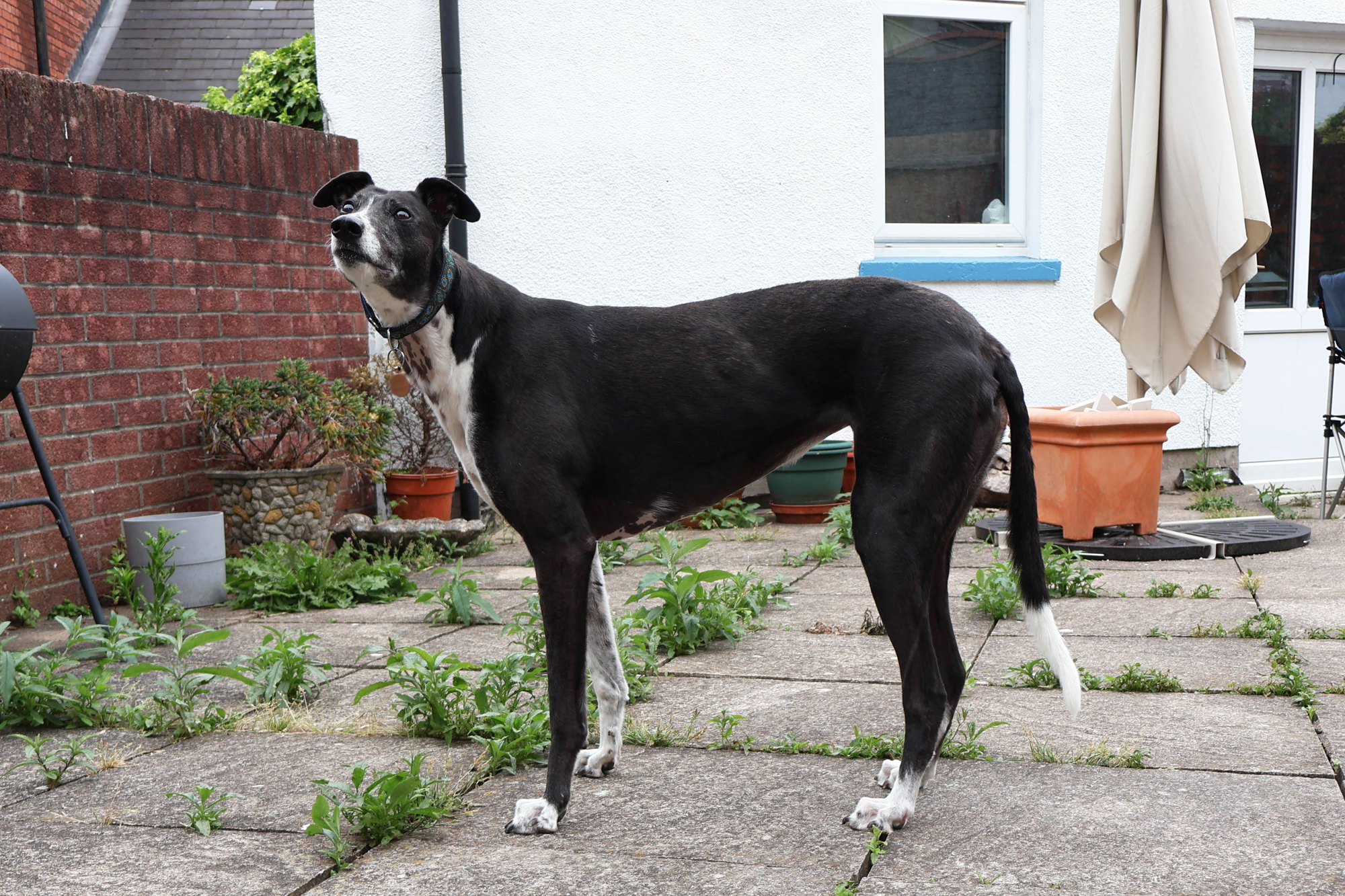
For photos, I tested the R50 with one of my greyhounds. The detection and tracking could keep up with her at a slow pace, tracking her body and even her eye, meaning I was able to get some sharp photos. As I found with the same tests on the EOS R10, though, the AF would lose track of the dog when she was running.
Canon EOS R50 review: Battery life
The Canon EOS R50’s battery life isn’t amazing, but certainly isn’t bad. Expect 440 shots using the screen and 310 using the EVF. Half a day of casual photography used up around half the charge, so it’s fair to say it can last all day if you’re not pushing it. We’d recommend buying a second battery though, especially if you plan to shoot video out and about.
You can charge the camera via the USB-C port, but Canon also include a wall charger for the battery as standard. With a second battery, a separate battery charger means you can keep shooting while charging a battery at the same time — very useful. It’s nice to see Canon doing this, as it’s something that other brands like Fuji and Sony have stopped doing, and it’s frustrating having to go out and buy a charger separately.
Canon EOS R50 review: Verdict
Whether you see the Canon EOS R50 as good value for money depends on where you are now in your photography/videography journey. If you already have some experience under your belt, perhaps with a DSLR or another mirrorless camera, and you want to branch out and start exploring your creative horizons with higher quality video and more professional features, it’s worth spending more money on something like an EOS R8 or Fujifilm X-T5. If you’re a little strapped for cash, the EOS R10.
But if you’re a beginner, or someone who just wants to shoot awesome looking video for social media, taking some photos along the way, this camera is a really tight package. It’s pricey for a beginner’s camera, but saving money by buying the EOS R100 would be a false economy — that camera is designed primarily for very casual, very automatic photography, and not much more. I won’t pretend that if it’s your first camera, the R50 is going to last you until you’re competing at Cannes, but if this is your first foray into video or photography, it has everything you’ll need for a while.







